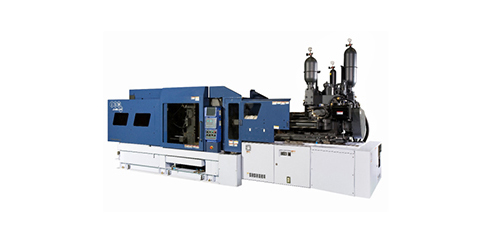4News -> Industry dynamics

Program control of injection speed
1. The program control of the injection speed is to divide the injection stroke of the screw into 3~4 stages, and use respective appropriate injection speeds in each stage. For example, slow down the injection speed when the molten plastic first passes through the gate, use high-speed injection during the filling process, and slow down the speed at the end of the filling process. Using this method can prevent flash, eliminate flow marks and reduce residual stress of plastic parts.
2. The flow rate is stable when filling the mold at low speed, the size of the plastic part is relatively stable, the fluctuation is small, the internal stress of the plastic part is low, and the internal and external stress of the plastic part tends to be the same (for example, the PC plastic part is immersed in carbon tetrachloride, and high-speed injection The molded plastic part has a tendency to crack, and it does not crack at low speed). Under relatively slow mold filling conditions, the temperature difference of the material flow, especially the large temperature difference between the material before and after the gate, helps to avoid the occurrence of shrinkage holes and dents. However, due to the long filling time, it is easy to cause delamination and poor welding of the plastic parts, which not only affects the appearance, but also greatly reduces the mechanical strength.
3. During high-speed injection, the material flow speed is fast. When the high-speed mold filling is smooth, the melt fills the cavity quickly, the material temperature drops less, and the viscosity drops slowly. Lower injection pressure can be used. Hot material filling mode situation. High-speed mold filling can improve the gloss and smoothness of the plastic parts, eliminate the phenomenon of weld marks and delamination, have small shrinkage depressions, uniform colors, and ensure fullness for larger parts of the plastic parts. However, it is easy to cause the plastic parts to become fat, blisters or yellow, or even burn the zoom, or cause difficulty in demolding, or uneven filling of the mold. For high-viscosity plastics, it may cause melt fracture, causing cloud spots on the surface of plastic parts.
High-speed and high-pressure injection can be considered in the following situations
1. The plastic melt has high viscosity and fast cooling speed. The long-flow plastic parts adopt low pressure and slow speed and cannot completely fill all corners of the cavity.
2. For plastic parts with too thin wall thickness, the melt is easy to condense and stay at the thin wall. A high-speed injection must be used to make the melt enter the cavity immediately before a large amount of energy is consumed.
3. Plastics reinforced with glass fiber, or plastics containing a larger amount of filler materials, due to poor fluidity, in order to obtain a smooth and uniform surface of plastic parts, high-speed and high-pressure injection must be used.
4. For high-end precision plastic parts, thick-walled plastic parts, plastic parts with large wall thickness changes, and plastic parts with thicker flanges and ribs, it is best to use multi-stage injection, such as two-stage, three-stage, and four-stage Even level five.
Program control of injection pressure
1. Generally, the control of injection pressure is divided into the control of primary injection pressure, secondary injection pressure or more than three injection pressures.
2. Whether the timing of pressure switching is appropriate is very important for preventing excessive pressure in the mold, preventing overflow or lack of material, etc. The specific volume of the molded part depends on the melt pressure and temperature when the gate is closed during the holding pressure stage. If the pressure and temperature are the same every time when switching from the holding pressure to the cooling stage of the plastic part, the specific volume of the plastic part will not change. At a constant molding temperature, the most important parameter that determines the size of the plastic part is the holding pressure, and the most important variables that affect the dimensional tolerance of the plastic part are the holding pressure and temperature. For example, after filling the mold, the holding pressure is immediately reduced. When the surface layer is formed to a certain thickness, the holding pressure rises again. In this way, a large plastic part with a thick wall can be molded with a low clamping force, eliminating sink marks and flash.
3. The holding pressure and speed are usually 50%~65% of the maximum pressure and speed when the plastic fills the cavity, that is, the holding pressure is about 0.6~0.8MPa lower than the injection pressure. Since the holding pressure is lower than the injection pressure, during the holding time, the load of the oil pump is low, so that the service life of the oil pump can be prolonged, and the power consumption of the oil pump motor is also reduced.
4. The three-stage pressure injection can not only make the plastic part fill the mold smoothly, but also won't appear weld marks, shrinkage depression, flashing and warping deformation. It is good for the injection molding of thin-walled plastic parts, small multi-cavity parts, large plastic parts with long processes, and even the injection molding of plastic parts with uneven cavity configuration and tight mold clamping.
Third, the program control of the plastic filling amount in the injection mold cavity
A certain metering is adjusted in advance, so that near the end of the injection stroke, there is still a small amount of melt (buffering amount) at the end of the screw, and the injection pressure (secondary injection pressure or three injection pressure) is further applied according to the filling situation in the mold. ), add a little melt. In this way, it is possible to prevent the plastic part from sinking or to adjust the shrinkage rate of the plastic part.
Program control of screw back pressure and speed
The high back pressure can make the melt obtain strong shearing force, and the low speed will also make the plastic get longer plasticizing time in the barrel. Therefore, the control of simultaneous programming of back pressure and speed is used more frequently. For example, in the screw metering full stroke, first high speed and low back pressure, then switch to lower speed, higher back pressure, then switch to high back pressure, low speed, and finally plasticization under low back pressure and low speed. In this way, most of the pressure of the melt in the front of the screw is released, and the rotational inertia of the screw is reduced, thereby improving the accuracy of screw measurement. Excessive back pressure often causes the degree of discoloration of the colorant to increase; the mechanical wear of the pre-plasticizing mechanism and the barrel screw increases; the pre-plasticizing cycle is prolonged, and the production efficiency is reduced; the nozzle is prone to casting and the amount of recycled material increases; even if self-locking is used If the back pressure of the nozzle is higher than the designed spring locking pressure, it will also cause fatigue damage. Therefore, the back pressure must be adjusted appropriately.



